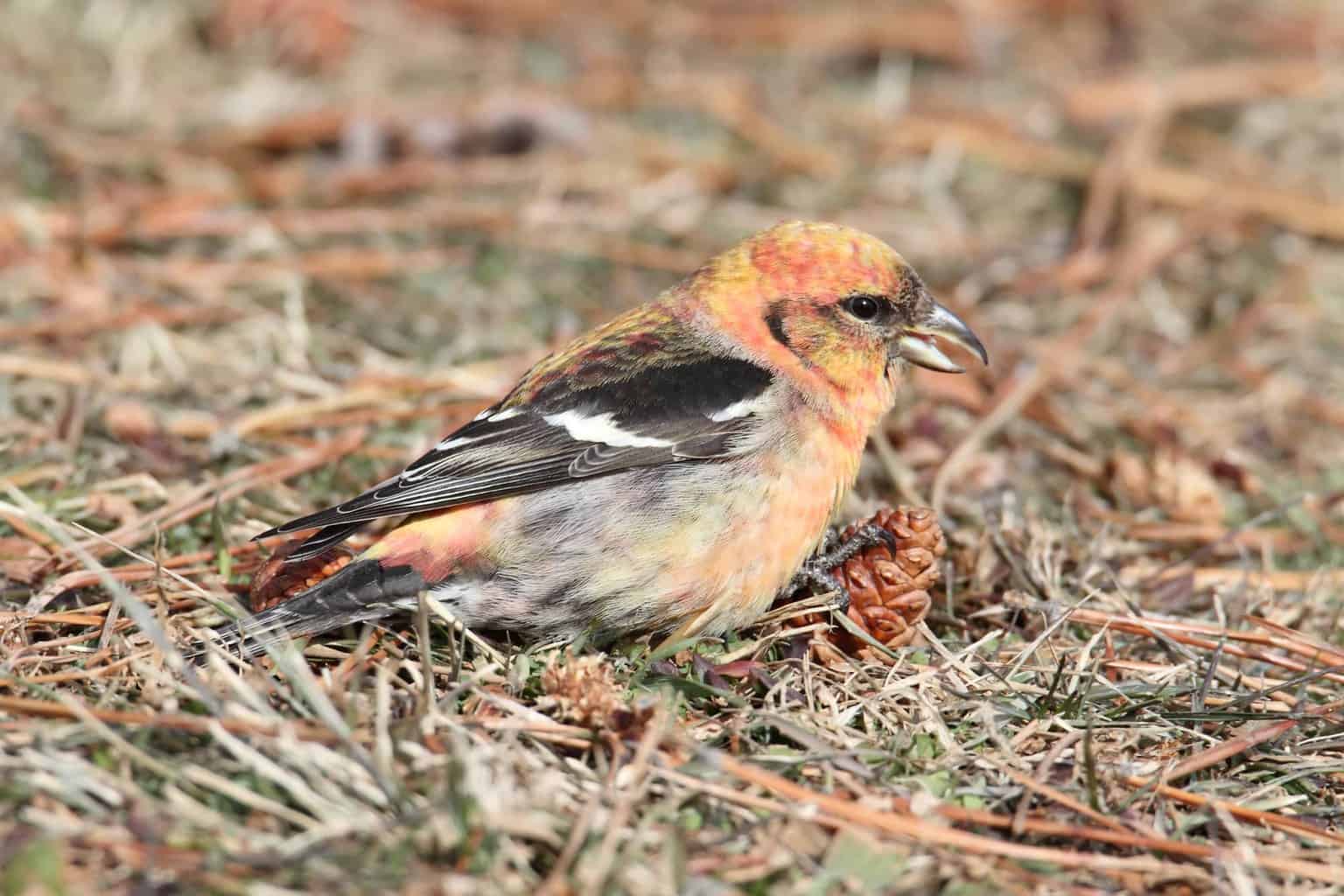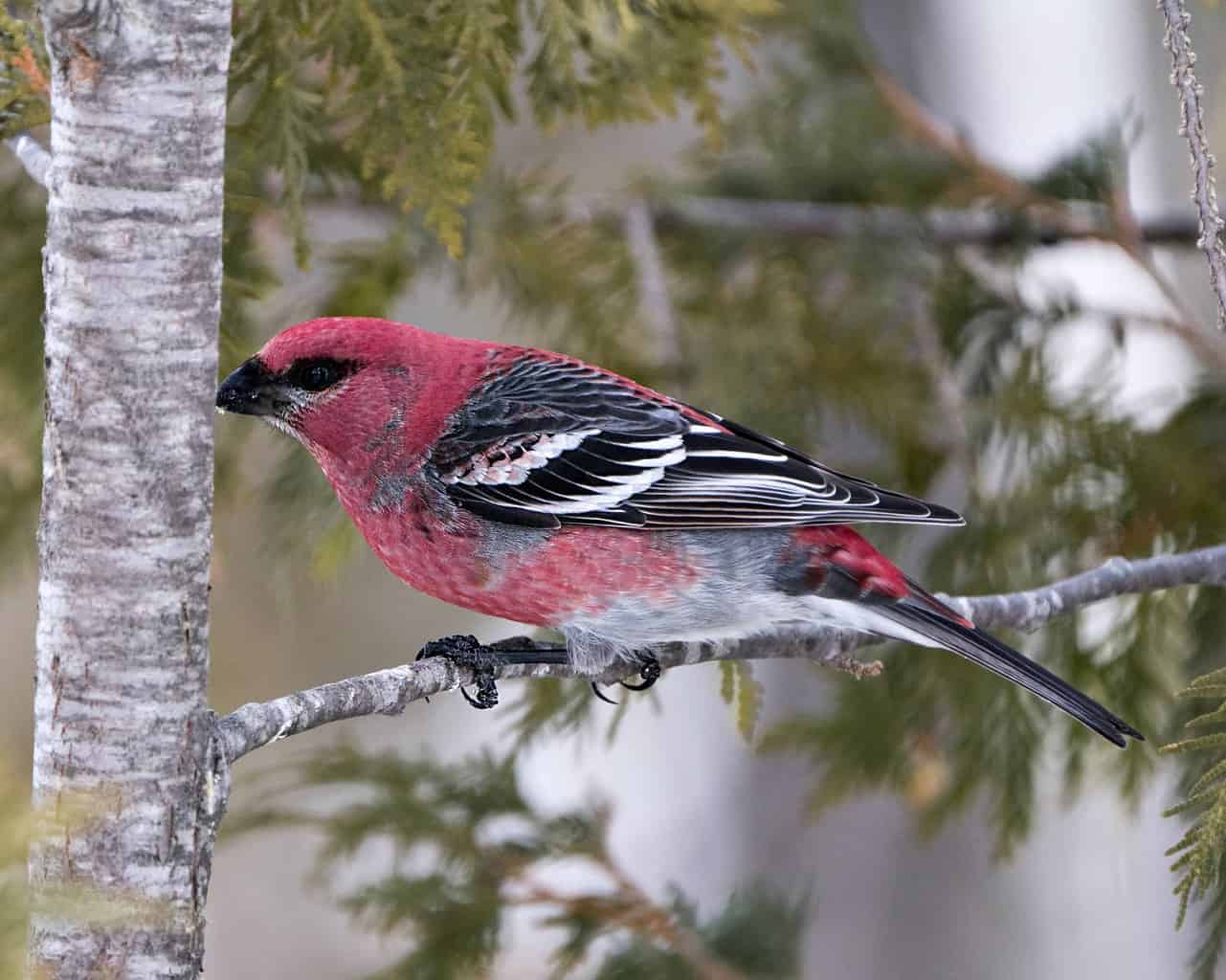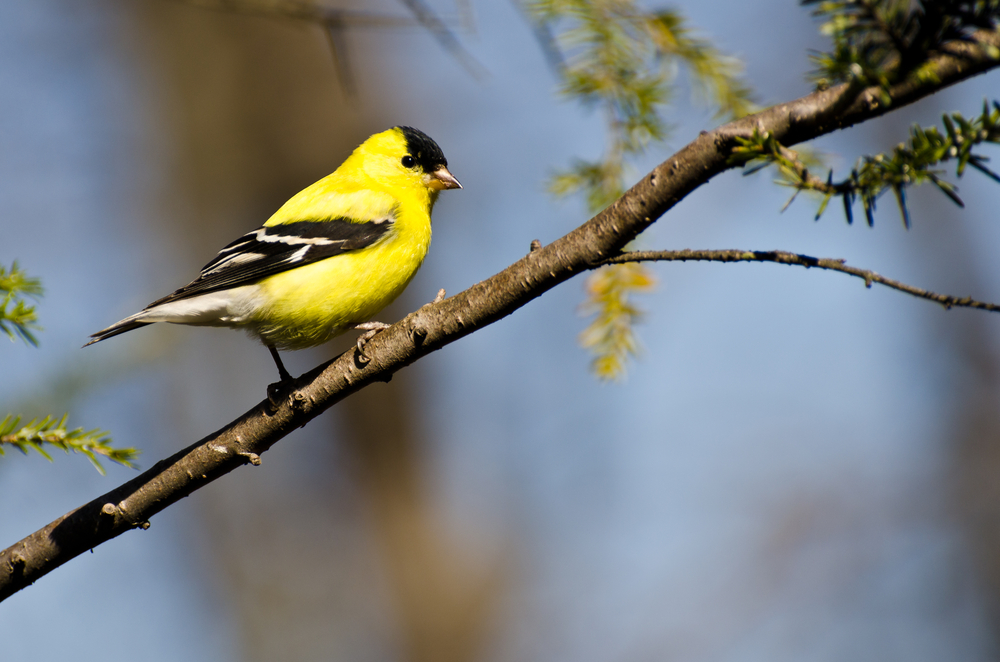Bordering Canada and the ocean, New Hampshire gives you an unparalleled front-row seat to nature’s best work. Whether you want to hike the Appalachian trail or try your hand at boating, there are 10 finches you can spot on the way.
Finches are voracious eaters of seeds, insects, and fruits. They thrive in diverse environments, making them one of the most accessible birds for beginner and experienced bird watchers.
Worried about missing out on your bird-watching hobby? I’ll help you fill up your must-see list with useful tips on these finch’s appearance, foraging habits, and more.
Purple Finch

- Species Name: Haemorhous purpureus
- Length: 12 cm to 16 cm
- Weight: 18 grams to 32 grams
- Wingspan: 22 cm to 26 cm
What better way to start off this list than with New Hampshire’s very own official bird? Not only is this bird officially iconic, but it has a rather striking appearance, too.
Appearance
The male purple finch may not have violet feathers, but it is a rather handsome shade of red. Blushing hues cover their head and back, transitioning into brown wings and a white belly.
Female purple finches are brown with white speckles all over. They have a distinctive white ‘eyebrow’ that makes them appear constantly surprised.
Range
It’s a small wonder that this finch became the state bird – it appears in New Hampshire year-round. However, you’ll spot more of this variety during the breeding season, so you may want to plan your trip between late April and early July.
New Hampshire is covered in evergreen forests, the purple finch’s favorite habitat for foraging and nesting.
Diet
Purple finches are usually on the ground pecking for seeds, but they’ll occasionally visit shrubs for flower buds or berries. While they’re easy to spot throughout the state, you can attract them to your feeder with white millet or black oil sunflower seeds.
Birdsong
The song of the purple finch is a rising and dipping warble with repetitive notes. There are often long pauses in between.
Fun Fact
If you’re lucky, you may be able to watch the purple finch’s elaborate mating dance. Males will puff up their chests and sing while holding nesting material in their beaks – pretty romantic if you ask me!
House Finch

- Species Name: Haemorhous mexicanus
- Length: 13 cm to 14 cm
- Weight: 16 grams to 27 grams
- Wingspan: 20 cm to 25 cm
Try not to get the purple finch confused with the house finch! Both birds boast similar coloration but with a few key differences.
Appearance
The male house finch is also a rosy red color but has brown streaks along its side and stomach. Male purple finches are much smoother overall and have a brighter stomach.
Female house finches’ feather colors are light yellow-brown, boasting brown streaks along their wings and stomachs. While they can appear like a sparrow at a glance, keep a close eye on their gray, conical bill.
Range
New Hampshire’s idyllic small towns and farms are some of the preferred stomping grounds of house finches. These birds show up in the state all year long but are a little more common in the winter.
House finches are also adaptable enough to be comfortable in parks and downtown areas when in search of food.
Diet
You can thank the house finch’s diet for contributing to their wide range, as they eat just about anything! Seeds, fruit, and flower buds are just a few items on their menu.
They’re particularly fond of orchards where they can dig into pears, plums, and strawberries. As such, you can easily attract house finches to your bird feeding station with black oil sunflower seeds or red mulberries.
Birdsong
Their birdcall is sweet and lilting, composed of twittering chir-chees and brisk warbles.
Fun Fact
Just how diverse does the house finch’s diet get? They’re also known to sip on maple sap.
Pine Siskin

- Species Name: Spinus Pinus
- Length: 11 cm to 14 cm
- Weight: 12 grams to 18 grams
- Wingspan: 18 cm to 22 cm
While not as common as the purple finch or house finch, the pine siskin shows up in New Hampshire regularly. The state’s abundance of pine trees means they have plenty of food.
Appearance
The male pine siskin has a light gray-brown body with black wing bars. They have a dusting of bright yellow or yellow-green along their wings and occasionally the back of their neck.
Female pine siskins look extremely similar to the males but have less yellow on the body.
Range
These social birds are year-round residents, usually hanging out in forests where they can dig into pine cones. However, they also forage on the ground for dropped seeds or flower buds.
When they’re low on seeds, they may eat the occasional caterpillar or spider.
Diet
The pine siskin earned its name for their love of conifers, spending hours per day digging around for nutrient-rich pine seeds. Since foraging is hard work, they’re eager for an easy meal at bird feeders.
Stock up on millet, nyjer, and hulled sunflower seeds to attract a few to your backyard. They’re also fans of suet when it gets cold!
Birdsong
I can never get over how excited this bird sounds. The pine siskin has a distinctive tzweee that almost sounds like childish squealing.
Fun Fact
Pine siskins are sociable birds and prefer to travel in flocks – expect to see quite a few of them in your backyard!
Common Redpoll

- Species Name: Acanthis flammea
- Length: 12 cm to 14 cm
- Weight: 11 grams to 20 grams
- Wingspan: 19 cm to 22 cm
Despite their name, the common redpoll is a dashing sight no matter how many times they appear.
Appearance
The male common redpoll has a light brown and gray body, distinctive for his cherry-red head. They also usually have a dusting of red along their chest.
Female common redpolls look similar to the males but with a white and brown-streaked chest. They don’t usually have a pink breast.
Range
While these birds don’t have the range of their house finch or pine siskin cousins, they’re still not hard to spot. Expect to see common redpolls in the wintertime, though they also show up in late fall.
Diet
Common redpolls are commonly spotted in weedy fields, thickets, and shrubs foraging for seeds. However, they’re also comfortable in boreal forests with plenty of pine trees.
They will occasionally visit bird feeders if you have Nyjer seeds or millet on hand. If you don’t have much luck, consider going on a winter hike in one of New Hampshire’s many forest trails or state parks.
Birdsong
Their birdcall is more subtle than their appearance, often composed of light chee-chee-chees.
Fun Fact
You don’t need to go back to English class to understand this finch’s scientific name – flammea is an ancient Latin word that means flame-colored.
Hoary Redpoll

- Species Name: Acanthis hornemanni
- Length: 12 cm to 14 cm
- Weight: 11 grams to 20 grams
- Wingspan: 22 grams to 23 grams
You may get the common redpoll mixed up with the hoary redpoll, but the latter has one major difference!
Appearance
While male common redpolls and hoary redpolls have red spots on their heads, look at the rest of their bodies. A male hoary redpoll will have a much paler body that stands stark against the environment.
Hoary redpolls also have smaller bills than common redpolls.
Female hoary redpolls are also pale with a red head spot but with subtle brown streaks on their stomach and sides.
Range
Since these hardy birds are big fans of frigid, tundra environments, even New Hampshire’s powerful winters don’t always attract them. Expect to spot them rarely in late winter or early spring.
While they usually linger in evergreen forests, you’ll sometimes see them flitting in and out of weedy fields.
Diet
These finches have a fairly diverse diet of seeds and insects. You may see a few at your feeder if you stock up on fresh sunflower or Nyjer seeds.
Birdsong
Hoary redpolls are boisterous and chatty members of the finch family, letting loose repetitive songs of cheet-cheet-cheets and chrt-chrts. They pause only rarely.
Fun Fact
Ever think about how fast childhood goes by? The hoary redpoll’s young leave the nest after just two weeks.
Red Crossbill

- Species Name: Loxia curvirostra
- Length: 14 cm to 17 cm
- Weight: 40 grams
- Wingspan: 25 to 27 cm
These stocky finches are one of the rarer species you’ll spot in New Hampshire, but don’t give up! Their diverse diet and wide range may still yield a chance encounter.
Appearance
Adult males have bold red bodies, gray wings, and white wing bars. Their dark bill has a distinctive crossed shape when closed, hence the name.
Quick tip: Red crossbills can sometimes come in yellow-orange color variations that almost look like different species.
The female red crossbill can be yellow-orange or yellow-green, boasting more gray coloration on her head and wings. She also has a distinctive crossed beak.
Range
The red crossbill range is diverse enough for bird watchers of different lifestyles. While these birds usually prefer to dig around coniferous forests for pine cones, they’re not startled by urban areas.
Expect to see these birds in New Hampshire year-round, even though they’re less common than other finches on this list.
Diet
Pine seeds are usually their food of choice, but they like to peck along roadsides for nutritious mineral salts.
If you want to increase your chances of spotting them, stock up your bird feeder with millet in the summer or suet in the winter months.
Birdsong
These birds have an intense, in-and-out warble that sounds a little like twee-er twee-er twee-er. You’ll also hear the occasional sharp trill.
Fun Fact
Red crossbills developed their fascinating beak shape to better slip inside pinecones to pull out seeds.
White-Winged Crossbill

- Species Name: Loxia leucoptera
- Length: 15 cm to 17 cm
- Weight: 24 grams to 26 grams
- Wingspan: 26 cm to 28 cm
Related to the red crossbill, the white-winged crossbill also has the quintessential criss-crossed beak. Fortunately for you, this one’s also easier to spot in New Hampshire.
Appearance
Male white-winged crossbills have vivid red bodies, dark gray-black wings, and two white wing bars. Unlike the red crossbill, their colors are a little more bold and they don’t usually come in variations of orange.
The female white-winged crossbill is light gray with olive along her chest.
Range
Spruce forests are the preferred feeding ground of choice for the white-winged crossbill. These beautiful birds show up year-round in the state, but you’ll see more during the winter months.
Diet
Spruce and tamarack seeds are these finches’ favorite food. These birds are so determined to get their seeds, you can find them feeding upside down!
You’ll also occasionally find these birds nibbling up rock salt on the side of the road.
Birdsong
This bird’s rapid-fire song is immediately distinctive with its chee-chee-chee and chr-chr-chrrrs.
Fun Fact
This finch’s name leucoptera stems from an Ancient Greek word that means white-winged.`
Evening Grosbeak

- Species Name: Hesperiphona vespertina
- Length: 16 cm to 22 cm
- Weight: 38 grams to 68 grams
- Wingspan: 30 cm to 36 cm
While less common in New Hampshire, this finch’s striking appearance will be incredibly easy to spot.
Appearance
The male evening grosbeak has a golden-yellow body with black wings and a black head. Their white wing bar and bold yellow brow stripe are easy to spot at a distance.
These plump finches also vary more in size, so focus more on their coloration to identify them properly.
The female evening grosbeak is a subtle bird, coated in a light gray with black and white wings. She’ll have a little hint of yellow along her neck.
Range
Evening grosbeaks show up year-round. If you’re thinking of hiking throughout New Hampshire’s beautiful mountain ranges, put this bird on your list – the evening grosbeak loves higher altitudes.
Diet
Evening grosbeaks are fond of seeds, berries, and foraging maple trees. However, they will sometimes visit your backyard during winter when they’re short on food.
Stock up on black oil sunflower seeds and consider getting a platform feeder to support their heavier weight.
Birdsong
These colorful finch species have an intense song composed of a sharp in-and-out trill that ends on a sharp note.
Fun Fact
These finches are nearly twice the size of most other finches and don’t usually feed off tube feeders as a result.
Pine Grosbeak

- Species Name: Pinicola enucleator
- Length: 20 cm to 25 cm
- Weight: 57 grams
- Wingspan: 33 cm
Are you a fan of hiking through winding forest trails and enjoying the crisp mountain air? You’ll have a higher chance of spotting the pine grosbeak, a rather rare finch in New Hampshire.
Appearance
The male pine grosbeak is a vibrant bird with a reddish-pink head and chest. Their wings are a soft gray-brown with a pale bill.
Female pine grosbeaks have a light gray body with a pop of yellow-orange on their head and rump. They look quite similar to juveniles.
Range
These birds usually prefer Canada, but since it’s a hop skip from New Hampshire, they’ll show up eventually. Expect to see them in late winter and early spring.
Diet
They regularly browse fir trees and pine trees for seeds and fruit. They’ll love your backyard bird feeders if you fill them with black oil sunflower seeds.
During winter, they may even visit for a little suet.
Birdsong
These beautiful finches almost sound like a wet, squeaky floor. Expect to hear the grosbeak song in a series of dainty twrr-twrrs or jaunty twee-tr-wees.
Fun Fact
While an enucleator may sound like a laser cannon from a sci-fi movie, it’s actually related to the Latin word enucleate. This word refers to their feeding habits and means to ‘remove the kernel’.
American Goldfinch

- Species Name: Spinus tristis
- Length: 11 cm to 13 cm
- Weight: 11 grams to 20 grams
- Wingspan: 19 cm to 22 cm
Wrapping up the list with one of the most charming birds, the American goldfinch is an easy bird to spot in New Hampshire. They’re a popular sight for their coloration and jaunty personality.
Appearance
The male American goldfinch is a gentle yellow with bold black wings and streaky white wing bars. They have a black patch on their head and a bright orange bill that stands out vividly.
The female American goldfinch is similar in coloration, but leaning toward yellow-olive.
Range
These colorful finches prefer to breed in Canada but will travel throughout the United States for the rest of the year. They’re a year-round bird in New Hampshire and love to show up in parks, gardens, backyards, and fields.
Depending on what time you visit forested park areas, you may spot a few owls, too!
Diet
If you have fresh seeds, these birds will adore you. Alongside foraging weedy fields and shrubby areas for food, they’ll visit feeders with sunflower seeds.
Birdsong
It’s a small wonder why this finch is so iconic – their musical voice is sweet as honey with bright, clear warbles and chwee-chr-chwee patterns.
Fun Fact
Since the male’s vivid coloration only shows up during the breeding season, their more subtle colors make them look like females.
New Hampshire Has Many Year-Round Finches to Enjoy Spotting
The Granite State is one of the easier bird enthusiast locations since so many finches linger year-round. Is it any wonder when this state has such an abundance of forests, mountains, and ocean vistas?
If you live in New Hampshire, you’ll also have plenty of opportunity to attract finches to your feeder. Make sure to get strategic and switch out your seeds for suet in the winter.
Want to learn more about bird life in New Hampshire? We have a guide on birds in New Hampshire to sharpen your knowledge.

